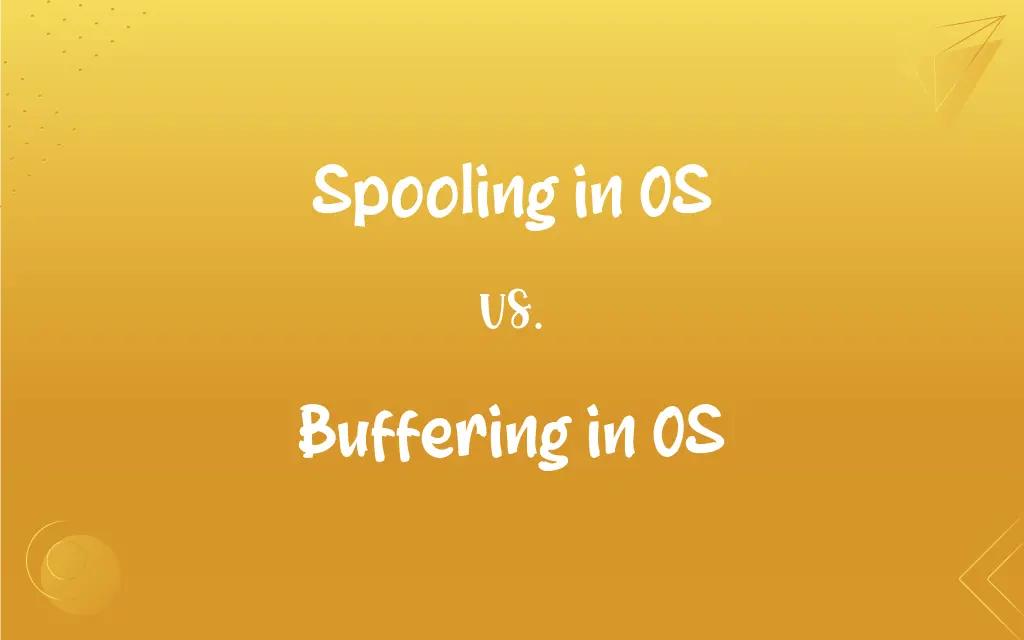Spooling in OS vs. Buffering in OS: What's the Difference?
Edited by Aimie Carlson || By Harlon Moss || Published on February 15, 2024
Spooling in OS refers to holding data in a temporary storage area for later processing, while buffering in OS temporarily stores data to smooth out differences in operational speed between devices.

Key Differences
Spooling in Operating Systems (OS) is a process where data is temporarily held in an area of memory known as a spool, usually on a disk, to be accessed and processed later by a device, such as a printer. Buffering in OS, on the other hand, is a technique used to temporarily store data in a buffer, a memory area, to balance the speed difference between producers and consumers of the data streams, like buffering a video stream.
Spooling is often used to manage data for devices that are not capable of concurrent data processing. For example, when multiple print jobs are sent to a printer, spooling allows these jobs to be stored and then processed one at a time. Buffering, in contrast, is mainly used to handle data transfer between devices operating at different speeds, ensuring a continuous flow of data and reducing the chance of a process being idle or data overflow.
The primary function of spooling is to enable the efficient use of different devices and resources by queuing multiple tasks. It can handle data from multiple processes and store them for sequential access. Buffering, however, primarily serves to accommodate a difference in the rate of data flow between sender and receiver or between two processes.
Spooling can be seen in various applications like printing and batch processing, where data is collected, stored, and then processed as a single batch. Buffering is evident in scenarios like streaming media, where data is buffered to prevent interruptions due to network latency or speed inconsistencies.
Another aspect of spooling is that the data in the spool can be re-ordered or prioritized before processing, which is not typically the case in buffering. In buffering, data is generally processed in the order it arrives, and the buffer serves merely as a temporary holding area to ensure smooth data transmission.
ADVERTISEMENT
Comparison Chart
Primary Purpose
Hold data for later processing
Smooth out operational speed differences
Usage Scenarios
Managing print jobs, batch processing
Streaming media, data transfers
Operation
Stores data for sequential access
Temporarily holds data for immediate processing
Data Handling
Can reorder or prioritize tasks
Processes data in the order it arrives
Impact on Device Efficiency
Enables efficient use of resources
Prevents idle time or overflow in processes
ADVERTISEMENT
Spooling in OS and Buffering in OS Definitions
Spooling in OS
Spooling in OS is the process of storing data temporarily for later processing by a device.
The OS uses spooling to manage multiple print jobs sent to the printer.
Buffering in OS
Buffering in OS temporarily stores data to manage the speed difference between input and output devices.
Buffering helps in smooth video playback by compensating for network speed variations.
Spooling in OS
Spooling helps in queuing tasks for sequential execution in OS.
Spooling allows the computer to queue several batch jobs for overnight processing.
Buffering in OS
Buffering allows for the temporary holding of data for immediate processing.
The OS uses buffering to manage data transfer between the processor and RAM efficiently.
Spooling in OS
Spooling can prioritize and reorder tasks in the queue.
The OS spools the print jobs, giving priority to urgent documents.
Buffering in OS
Buffering is used in OS to prevent data overflow when the production rate exceeds the consumption rate.
Buffering ensures continuous data flow between the hard drive and the application.
Spooling in OS
Spooling allows multiple applications to send data without waiting for the immediate availability of a resource.
Thanks to spooling, different users can send their printing tasks without delay.
Buffering in OS
Buffering smooths out the operational speed differences between various system components.
Buffering is critical in maintaining a balance between the faster CPU and slower I/O devices.
Spooling in OS
Spooling in OS is useful in environments where devices cannot multitask.
Spooling is essential for printers that cannot handle multiple tasks simultaneously.
Buffering in OS
Buffering in OS helps in reducing the idle time of devices waiting for data.
Buffering minimizes delays in data processing by keeping a steady stream of data.
FAQs
How does spooling improve system efficiency?
Spooling improves efficiency by allowing a device to receive data at its own pace and multitasking.
What are common uses of spooling?
Common uses include print spooling, where print jobs are stored before being sent to a printer.
What is spooling in operating systems?
Spooling is a process in which data is temporarily held to be used and executed by a device, program, or the system.
How does spooling work in OS?
Spooling works by placing data in a temporary storage area called a spool, allowing devices or programs to access it when ready.
Is spooling dependent on the speed of devices?
Spooling is not heavily dependent on device speed as it stores data until the device is ready.
What are the advantages of spooling in OS?
Advantages include efficient use of resources, multitasking, and reducing device idle time.
What are common uses of buffering?
Common uses include streaming media, data transfer between devices, and I/O operations.
Is spooling a form of multitasking?
Yes, spooling allows for multitasking by managing multiple I/O requests with a buffer.
What is the difference between spooling and buffering?
Spooling involves managing entire jobs, while buffering manages just the data being transferred between components.
Does spooling require a lot of memory?
Spooling can require significant memory, depending on the number and size of jobs being spooled.
How do buffers work in a network?
In networks, buffers temporarily store data packets to ensure smooth transmission and prevent data loss.
What is buffering in operating systems?
Buffering is a process of storing data in a memory area known as a buffer while it is being transferred between two devices or between a device and an application.
How does buffering work?
Buffering temporarily holds data in a buffer to manage differences in operation speed between producer and consumer processes or devices.
Is buffering important for video streaming?
Yes, buffering is crucial for smooth video streaming, reducing interruptions due to slow network speeds.
Does buffering require a lot of memory?
The memory requirement depends on the amount of data and the purpose of buffering.
Can spooling lead to faster processing?
Yes, spooling can enhance overall processing speed by allowing simultaneous data processing and data transfer.
How does buffering improve performance?
Buffering enhances performance by reducing the impact of speed differences between processing units and I/O devices.
What's the difference between buffering and caching?
Buffering is for managing data flow, while caching is for storing frequently accessed data for quick access.
Is buffering a form of data management?
Yes, buffering is a method of managing data during transmission or processing.
Can buffering occur in hardware and software?
Yes, buffering can be implemented in both hardware and software.
About Author
Written by
Harlon MossHarlon is a seasoned quality moderator and accomplished content writer for Difference Wiki. An alumnus of the prestigious University of California, he earned his degree in Computer Science. Leveraging his academic background, Harlon brings a meticulous and informed perspective to his work, ensuring content accuracy and excellence.
Edited by
Aimie CarlsonAimie Carlson, holding a master's degree in English literature, is a fervent English language enthusiast. She lends her writing talents to Difference Wiki, a prominent website that specializes in comparisons, offering readers insightful analyses that both captivate and inform.







































































